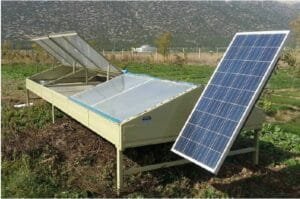 Sun-dried vegetables and fruits are beloved for their rich flavors, extended shelf life, and concentrated nutrients. But have you ever wondered about the journey these delicacies undertake to reach your pantry? From the initial stages of cultivation to the final packaging, the process is a fascinating blend of tradition, science, and sustainability. Let’s dive into the step-by-step journey of sun-dried produce and discover how nature’s bounty is transformed into these wholesome delights.
Sun-dried vegetables and fruits are beloved for their rich flavors, extended shelf life, and concentrated nutrients. But have you ever wondered about the journey these delicacies undertake to reach your pantry? From the initial stages of cultivation to the final packaging, the process is a fascinating blend of tradition, science, and sustainability. Let’s dive into the step-by-step journey of sun-dried produce and discover how nature’s bounty is transformed into these wholesome delights.
1. Cultivation and Harvesting
The journey begins on organic farms where fruits and vegetables are cultivated using natural methods. Farmers prioritize high-quality produce by:
- Choosing nutrient-rich soil and organic fertilizers.
- Avoiding synthetic pesticides and herbicides to ensure chemical-free crops.
- Harvesting at peak ripeness for maximum flavor and nutritional value.
Fruits like apricots, tomatoes, and mangoes, and vegetables like bell peppers and zucchini, are carefully selected based on their suitability for the drying process.
2. Sorting and Cleaning
Once harvested, the produce undergoes thorough sorting and cleaning. This step ensures that only the best fruits and vegetables are used. Key processes include:
- Sorting: Removing bruised, overripe, or under-ripe items.
- Washing: Using clean water to eliminate dirt, dust, and potential contaminants.
-
Pre-treatment: For certain fruits, pre-treatments like dipping in lemon juice or salt water help retain color and enhance drying efficiency.
3. Slicing and Preparation
To facilitate even drying, the produce is sliced into uniform pieces. The size and thickness depend on the type of fruit or vegetable and its intended use. For example:
- Tomatoes may be halved or quartered.
- Fruits like apples or mangoes are thinly sliced for quicker drying.
- Vegetables like zucchini or bell peppers are cut into strips or rounds.
Uniform slicing ensures consistent drying and prevents spoilage during the process.
4. The Sun-Drying Process
The heart of the journey lies in the sun-drying process, where the magic of nature takes center stage. Here’s how it unfolds:
Optimal Environment
The produce is laid out on drying racks or trays, placed in areas with:
- Direct sunlight.
- Low humidity.
- Good air circulation.
Protective Measures
To ensure cleanliness and hygiene:
- Mesh covers shield the produce from insects and debris.
- Trays are regularly monitored and rotated to ensure even drying.
Time and Patience
Depending on the type of produce, sun-drying can take anywhere from a few days to a week. During this time, the water content is reduced to about 10-15%, concentrating the natural sugars, flavors, and nutrients.
5. Quality Inspection
Once dried, the produce undergoes a meticulous quality inspection to ensure it meets food safety standards. This step involves:
- Checking for proper dehydration: Ensuring the produce is pliable but not moist.
- Identifying imperfections: Removing pieces that are over-dried, under-dried, or damaged.
-
Testing for contaminants: Ensuring the absence of mold, insects, or foreign particles.
6. Packaging and Storage
Proper packaging is crucial to maintaining the quality and longevity of sun-dried fruits and vegetables. The steps include:
- Sealing: Using airtight, moisture-proof packaging to prevent rehydration and contamination.
- Labeling: Providing information about the product’s origin, drying method, and storage recommendations.
-
Storage: Storing in cool, dark conditions to preserve flavor and nutritional integrity until it reaches consumers.
7. Distribution and Retail
The final leg of the journey involves transporting the packaged goods to retailers and markets. Key considerations include:
- Maintaining proper storage conditions during transit.
- Distributing to health food stores, supermarkets, and online platforms.
-
Ensuring traceability to guarantee the authenticity of organic products.
Why Choose Sun-Dried Produce?
The journey from farm to pantry is a testament to the care and precision involved in creating sun-dried fruits and vegetables. Here’s why they deserve a place in your kitchen:
1. Nutritional Benefits
Sun-dried produce retains most of its vitamins, minerals, and antioxidants, offering a nutrient-dense option for snacking and cooking.
2. Natural and Chemical-Free
The absence of preservatives and artificial additives makes sun-dried foods a clean and wholesome choice.
3. Sustainable and Eco-Friendly
By leveraging solar energy, sun-drying is a sustainable preservation method that minimizes environmental impact.
4. Versatile and Convenient
Sun-dried fruits and vegetables are easy to store and use, making them ideal for a variety of dishes, from salads and soups to baked goods and snacks.
Tips for Enjoying Sun-Dried Foods
-
Rehydrating: Soak sun-dried vegetables in warm water or broth for a few minutes before adding them to recipes.
- Snacking: Enjoy dried fruits like apricots, raisins, or mangoes as a quick and healthy snack.
- Cooking: Use sun-dried tomatoes in pasta dishes, pizzas, or sauces for a burst of flavor.
-
Storage: Keep in airtight containers in a cool, dark place to maintain freshness.
Conclusion
The journey of sun-dried vegetables and fruits from farm to pantry is a beautiful blend of nature, tradition, and careful craftsmanship. By choosing sun-dried produce, you’re not only embracing a nutritious and flavorful option but also supporting sustainable practices that honor the environment. So the next time you enjoy a handful of sun-dried apricots or add sun-dried tomatoes to your favorite dish, remember the meticulous journey that brought these natural treasures to your table.


